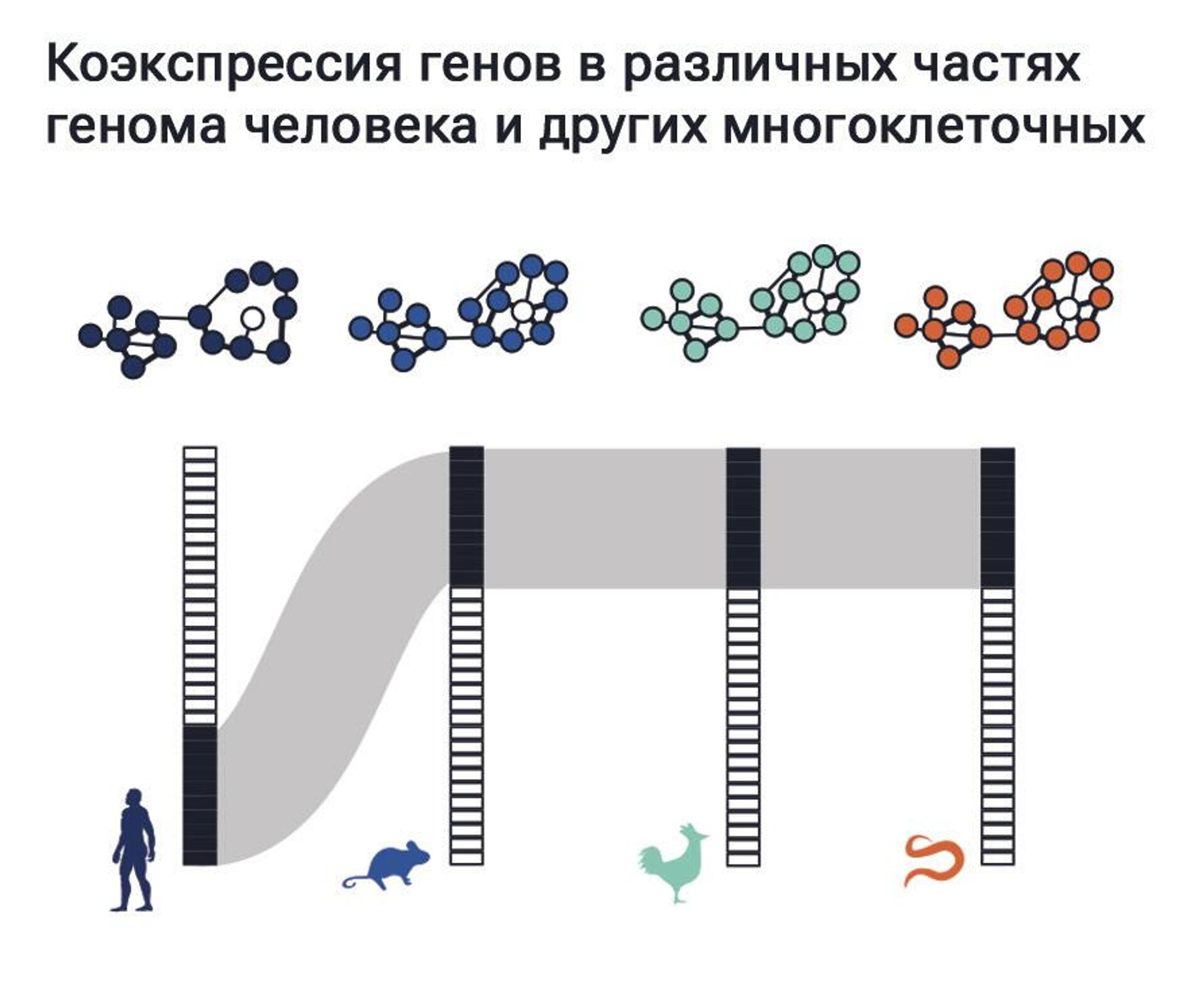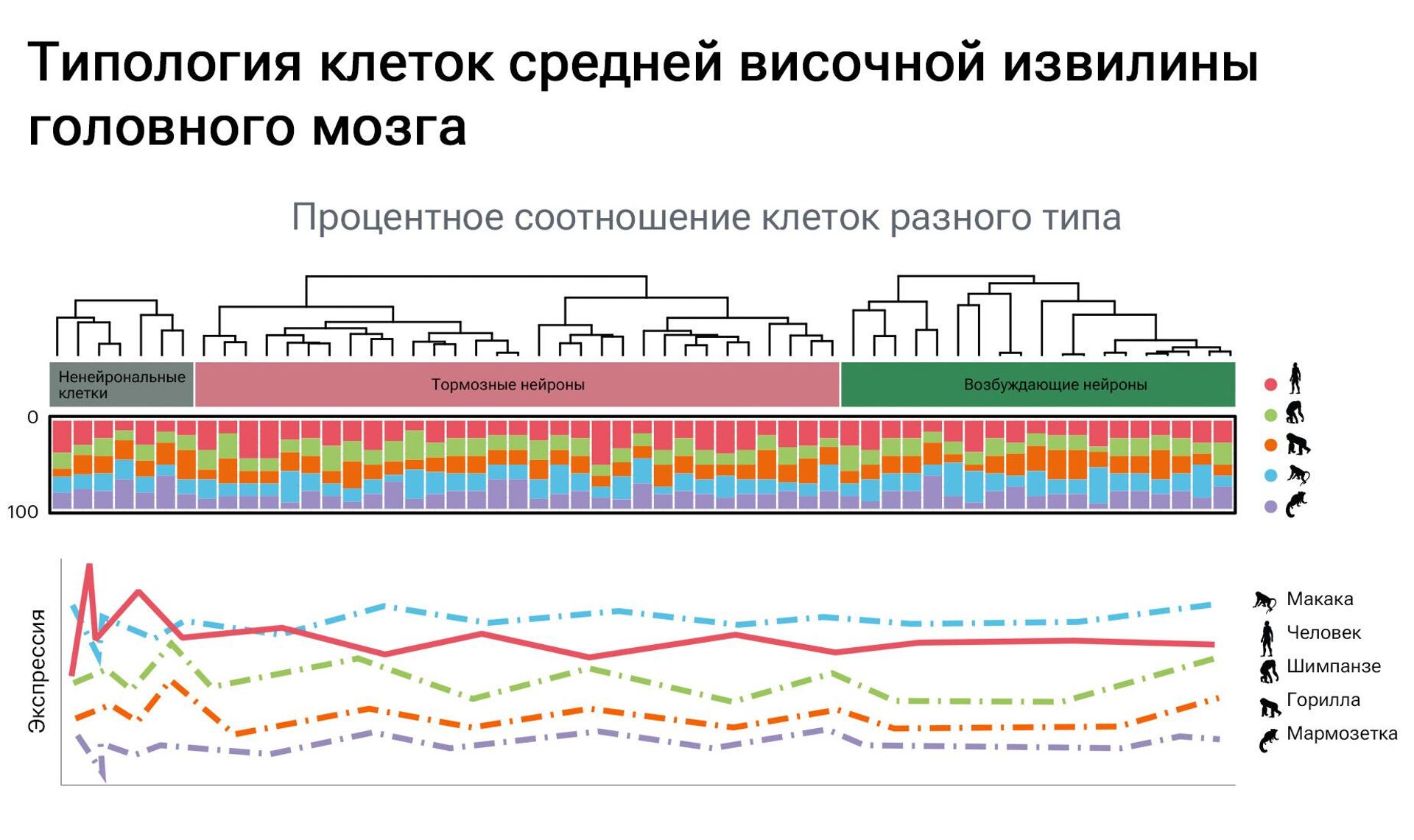
MOSCOW, December 27, Vladislav Strekopytov. Neuroscientists have created genetic maps of the brain for each primate species and discovered 139 genes that are highly expressed only in humans. Perhaps they were the ones who led to the emergence of intelligence.
Looking for differences
All the features that distinguish humans from animals — developed speech, consciousness, high cognitive abilities that allow them to learn new things and use them in practice — are associated with higher nervous activity, for which the brain is responsible. By studying it, neuroscientists are trying to find something that only representatives of Homo sapiens have and are absent from their closest relatives — other primates.
To do this, they compare the anatomy and structure of the brain and its parts, conduct genetic and molecular studies, and analyze chemical and signaling processes in the central nervous system. The focus is on specialized nerve cells—neurons—and the connections between them. Thanks to the advent of new generation genetic analysis methods, such as DNA and RNA sequencing of single cells, it has become possible to study the brain at a fundamentally new level.
Disassemble down to the cell
In 2013, a large international project to create maps of brain activity, the BRAIN Initiative, was launched. Its first part, called the BRAIN Initiative Cell Census Network (BICCN), ended in 2021 with the compilation of an Atlas of cell types and anatomical neural diagram of the primary motor cortex of mammals — mice, monkeys and humans — as the basis for an in-depth study of cells in other parts of the brain. More than 250 scientists from 45 institutions on three continents took part in the work, and the results were published in 17 articles in a special issue of the journal Nature.
The human brain is made up of billions of nerve cells that form trillions of connections called synapses. Different types of neurons influence certain brain functions, but their quantitative relationship was previously unknown. Based on the genetic profile, the authors of the atlas identified more than a hundred cell subtypes, organized into several levels of hierarchy.
The work used analysis of the transcriptome—the complete set of gene readouts in a cell, which contains instructions for creating proteins—and the epigenome—a set of chemical modifications to the cell’s DNA that determines the way genetic information is expressed. Transcriptomic information was obtained for 2.2 million cell nuclei, about a million neurons were subjected to epigenetic analysis, and patch sequencing was performed for 500. This novel technique allows for the simultaneous collection of molecular, anatomical and physiological information from the same cells.
Comparative analysis reveals significant differences in the number of neuron types in the brains of mice, several species of monkeys and humans. Thus, in the primary motor cortex of the brain of marmoset monkeys, 94 clusters were identified, and in human samples — 127 types, and only 45 types were common to all. The study authors attribute this to the evolutionary expansion of brain cell functions from more primitive mammals to primates, and then to humans.
September 11, 2022, 08:00
Special cells
Neuroscientists from the University of Texas Southwestern Medical Center, led by Professor Genevieve Konopka, compared the activity of different types of neurons in humans, chimpanzees and rhesus monkeys and found that the human brain has specialized nerve cells responsible for adapting to a changing environment and processing new experiences. There are also more genes in human neurons that influence speech development.
Previously, scientists documented differences in oligodendrocytes in the brains of humans and chimpanzees. These are specific cells that surround neurons, helping them process and transmit signals faster. It turned out that in humans, compared to primates, gene activity in preoligodendrocytes—still immature brain cells—continues into adulthood. Genes are activated every time in response to injury, stress, and any unusual situation. This mechanism allows a person to learn throughout his life.
Researchers hope that their discovery will have specific practical applications — it will help develop new methods of treating schizophrenia, Alzheimer's disease and other neurodegenerative diseases, in which, as the authors found, the function of oligodendrocytes.
In another experiment described in the same article, Dr. Konopka and his colleagues compared the DNA of neurons of modern humans, Neanderthals and Denisovans. Scientists analyzed not only the genetic code itself, but also the cellular mechanisms that regulate gene expression. And they identified dozens of genes whose functions are different in representatives of our species and their ancient relatives. There are especially many differences in the neurons of the posterior cingulate cortex — the part of the brain responsible for mental activity in the waking state.
The general conclusion that the authors make is that increased cognitive abilities in humans arose as a result of the evolutionary expansion of the functions of the cerebral cortex and an increase in its cellular diversity.
The power of evolution
Recently, scientists from the United States and Canada, led by Associate Professor Jesse Gillis from the Center for Cellular and Biomolecular Research at the University of Toronto, published the results of a study that traces the divergence of gene function in humans and four species of primates: chimpanzees, gorillas, macaques and marmosets.
< br />Using the BICCN single-cell transcriptomic database of neurons, the researchers found 139 genes common to all primates in cells in the middle temporal gyrus of the brain that are highly expressed only in the human brain. They are also characterized by a special profile of co-expression — mutual reinforcement, which is not found in other multicellular organisms.
About half of the genes specific to the human brain are expressed in neurons of the gray matter, the other half in non-neuronal cells of the white matter, which consists mainly of bundles of nerve fibers connecting different regions of the gray matter. The coordination between different parts of the brain and the speed of information processing largely depend on how effectively impulses are transmitted between neurons along these fibers.
Some of the isolated genes, such as NHEJ1, GTF2H2, C2 and BBS5, have been well studied. They are known to be resistant to severe loss-of-function mutations and can evolve rapidly under evolutionary selection. Perhaps, the researchers believe, at some point in evolution, selective pressure at the cellular level was low, which allowed these genes to take on higher-level cognitive functions, which became the source of the unique abilities of Homo sapiens.
“There are about 570 thousand cells in the cell atlas of the middle temporal gyrus of primates,” the lead author of the article, Khamsini Suresh, a researcher at the Stanley Institute for Cognitive Genomics in New York, is quoted in a press release as saying in a press release. “Genes developed in humans «were apparently tolerant of change. Our superior cognitive performance may have resulted from the evolutionary adaptation of human brain cells to a variety of less dangerous mutations.»
About a quarter of the identified genes are in some way associated with various brain diseases . The authors expect that the information obtained will also make it possible to get closer to unraveling the nature of some intractable mental disorders and neurodegenerative conditions.


























































Свежие комментарии